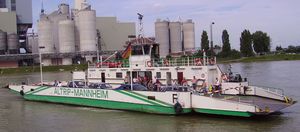Ferry
A ferry (or ferryboat) is a form of transportation, usually a boat, but sometimes a ship, used to carry (or ferry) primarily passengers, and sometimes vehicles and cargo as well, across a body of water. Most ferries operate on regular, frequent, return services. A passenger ferry with many stops, such as in Venice, is sometimes called a water bus or water taxi.
Ferries form a part of the public transport systems of many waterside cities and islands, allowing direct transit between points at a capital cost much lower than bridges or tunnels. However, ship connections of much larger distances (such as over long distances in water bodies like the Mediterranean Sea) may also be called ferry services, especially if they carry vehicles.

Contents
History
| |
This section requires expansion. |
In ancient times
The profession of the ferryman is embodied in Greek mythology in Charon, the boatman who transported souls across the River Styx to the Underworld.
Speculation that a pair of oxen propelled a ship having a water wheel can be found in 4th century Roman literature “Anonymus De Rebus Bellicis”. Though impractical, there is no reason why it could not work and such a ferry, modified by using horses, was used in Lake Champlain in 19th-century America. See “When Horses Walked on Water: Horse-Powered Ferries in Nineteenth-Century America" (Smithsonian Institution Press; Kevin Crisman, co-authored with Arthur Cohn, Executive Director of the Lake Champlain Maritime Museum).
Notable services

The busiest seaway in the world, the English Channel, connects Great Britain and mainland Europe sailing mainly to French ports, such as Calais, Boulogne, Dieppe, Cherbourg-Octeville, Caen, St Malo and Le Havre. Ferries from Great Britain also sail to Belgium, Denmark, the Netherlands, Norway, Spain and Ireland. Some ferries carry mainly tourist traffic, but most also carry freight, and some are exclusively for the use of freight lorries.
Large cruiseferries sail in the Baltic Sea between Finland, Sweden, Germany and Estonia, and from Italy to Albania and Greece. In many ways, these ferries are like cruise ships, but they can also carry hundreds of cars on car decks. In Britain, car-carrying ferries are sometimes referred to as RORO (roll-on, roll-off) for the ease by which vehicles can board and leave.
In Istanbul, ferries connect the European and Asian shores of Bosphorus as well as Princes Islands and nearby coastal towns.

In Australia, two Spirit of Tasmania ferries carry passengers and vehicles 300 kilometres across Bass Strait, which separates Tasmania from the Australian mainland. These run overnight but also include day crossings in peak time. Both ferries are based in the northern Tasmanian port city of Devonport and sail to Melbourne.
In New Zealand, ferries connect Wellington in the North Island with Picton in the South Island, linking New Zealand's two main islands. The 92 km route takes three hours, and is run by two companies – government-owned Interislander, and independent Bluebridge.
Hong Kong has the Star Ferry carry passengers across Victoria Harbour and various carriers carrying travellers between Hong Kong Island to outlying islands like Cheung Chau, Lantau Island and Lamma Island.
Due to the numbers of large freshwater lakes and length of shoreline in Canada, many provinces and territories have ferry services. BC Ferries carries travellers between Vancouver Island and the British Columbia mainland on the country's west coast. This ferry service operates to other islands including the Gulf Islands and the Queen Charlotte Islands. Canada's east coast has been home to numerous inter and intra provincial ferry and coastal services, including a large network operated by the federal government under CN Marine and later Marine Atlantic. Private and publicly owned ferry operations in eastern Canada include Marine Atlantic, serving the island of Newfoundland, as well as Bay, NFL, CTMA, Coastal Transport, and STQ to name but a few. Canadian waters in the Great Lakes once hosted numerous ferry services, however these have been reduced to those offered by Owen Sound Transportation and several smaller operations. There are also several commuter passenger ferry services operated in major cities, such as Metro Transit in Halifax, Toronto Island Ferry in Toronto and SeaBus in Vancouver.
Washington State Ferries operates the most extensive ferry system in the United States, with ten routes on Puget Sound and the Strait of Juan de Fuca serving terminals in Washington and Vancouver Island. In fiscal year 1999, Washington State Ferries carried 11 million vehicles and 26 million passengers. The Staten Island Ferry in New York City, sailing between the boroughs of Manhattan and Staten Island, is the nation's single busiest ferry route by passenger volume. New York City also has a network of smaller ferries, or water taxis, that shuttle commuters along the Hudson River from locations in New Jersey and Northern Manhattan down to the midtown, downtown and Wall Street business centers.
Vehicle-carrying ferry services between mainland Cape Cod and the islands of Martha's Vineyard and Nantucket are operated by The Woods Hole, Martha's Vineyard and Nantucket Steamship Authority, which sails year-round between Woods Hole and Vineyard Haven as well as Hyannis and Nantucket. Seasonal service is also operated from Woods Hole to Oak Bluffs from Memorial Day to Labor Day. As there are no bridges or tunnels connecting the islands to the mainland, The Steamship Authority ferries in addition to being the only method for transporting private cars to or from the islands, also serves as the only link by which heavy freight and supplies such as food and gasoline can be trucked to the islands. Additionally, Hy-Line Cruises operates high speed catamaran service from Hyannis to both islands, as well as traditional ferries, and several smaller operations run seasonal passenger only service primarily geared towards tourist day-trippers from other mainland ports, including New Bedford, (New Bedford Fast Ferry) Falmouth, (Island Queen ferry and Falmouth Ferry) and Harwich (Freedom Cruise Line).
The San Francisco Bay Area has several ferry services, such as the Blue & Gold Fleet, connecting with cities as far as Vallejo. The majority of ferry passengers are daily commuters and tourists. The only way to get to Alcatraz is by ferry.
Until the completion of the Mackinac Bridge in the 1950s, ferries were used for vehicle transportation between the Lower Peninsula of Michigan and the Upper Peninsula of Michigan, across the Straits of Mackinac in the United States. Ferry service for bicycles and passengers continues across the straits for transport to Mackinac Island, where motorized vehicles are almost completely prohibited. This crossing is made possible by three ferry lines, Arnold Transit Company, Shepler's Ferry, and Star Line Ferry.
Types
Ferry designs depend on the length of the route, the passenger or vehicle capacity required, speed requirements and the water conditions the craft must deal with.
Double-ended
Double-ended ferries have interchangeable bows and sterns, allowing them to shuttle back and forth between two terminals without having to turn around. Well-known double-ended ferry systems include the Staten Island Ferry, Washington State Ferries, Star Ferry, several boats on the North Carolina Ferry System, and the Lake Champlain Transportation Company. Most Norwegian fjord and coastal ferries are double-ended vessels. Some ferries in Sydney, Australia and British Columbia are also double-ended. In 2008, BC Ferries launched three of the largest double-ended ferries in the world.
Hydrofoil
Hydrofoils have the advantage of higher cruising speeds, succeeding hovercraft on some English Channel routes where the ferries now compete against the Eurotunnel and Eurostar trains that use the Channel Tunnel. Passenger-only hydrofoils also proved a practical, fast and relatively economical solution in the Canary Islands but were recently replaced by faster catamaran "high speed" ferries that can carry cars. Their replacement by the larger craft is seen by critics as a retrograde step given that the new vessels use much more fuel and foster the inappropriate use of cars [2] in islands already suffering from the impact of mass tourism.
Hovercraft
Hovercraft were developed in the 1960s and 1970s to carry cars. The largest was the massive SR.N4 which carried cars in its centre section with ramps at the bow and stern between England and France. The hovercraft was superseded by catamarans which are nearly as fast and are less affected by sea and weather conditions. Only one service now remains, a foot passenger service between Portsmouth and the Isle of Wight run by Hovertravel.
Catamaran

Catamarans are normally associated with high-speed ferry services. Stena Line operates the largest catamarans in the world, the Stena HSS class, between the United Kingdom and Ireland. These waterjet-powered vessels, displacing 19,638 tonnes, are larger than most catamarans and can accommodate 375 passenger cars and 1,500 passengers. Other examples of these super-sizer catamarans are found in the Brittany Ferries fleet with the Normandie Express and the Normandie Vitesse.
Ro-ro

Roll-on/roll-off ferries (RORO) are large, conventional ferries named for the ease by which vehicles can board and leave. Most of the world's largest RORO ferries operate between Great Britain and mainland Europe and the Republic of Ireland. Irish Ferries' MS Ulysses is the world's largest RORO ferry.
Cruiseferry
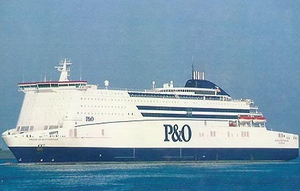
A cruiseferry is a ship that combines the features of a cruise ship with a RoRo ferry.
Fast RoPax Ferry
Fast RoPax ferries are conventional ferries with a large garage intake and a relatively large passenger capacity, with conventional diesel propulsion and propellers that sail over 25 knots (46 km/h; 29 mph). Pioneering this class of ferries was Attica Group, when it introduced Superfast I between Greece and Italy in 1995 through its subsidiary company Superfast Ferries.
Turntable ferry
This type of ferry allows vehicles to load from the "side". The vehicle platform can be turned. When loading, the platform is turned sideways to allow sideways loading of vehicles. Then the platform is turned back, in line with the vessel, and the journey across water is made.
Pontoon ferry
Pontoon ferries carry vehicles across rivers and lakes and are widely used in less-developed countries with large rivers where the cost of bridge construction is prohibitive. One or more vehicles are carried on a pontoon with ramps at either end for vehicles to drive on and off. Cable ferries (next section) are usually pontoon ferries, but pontoon ferries on larger rivers are motorised and able to be steered independently like a boat.
Foot ferry
Foot ferries are small craft used to ferry foot passengers, and often also cyclists, over rivers. These are either self-propelled craft or cable ferries. Such ferries are for example to be found on the lower River Schelde in Belgium and in particular the Netherlands. Regular foot ferry service also exists in the capital of the Czech Republic, Prague. Restored, expanded ferry service in the Port of New York and New Jersey uses boats for pedestrians only.
Cable ferry
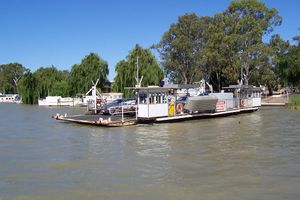
Very short distances may be crossed by a cable or chain ferry, which is usually a pontoon ferry (see above), where the ferry is propelled along and steered by cables connected to each shore. Sometimes the cable ferry is human powered by someone on the boat. Reaction ferries are cable ferries that use the perpendicular force of the current as a source of power. Examples of a current propelled ferry are the four Rhine ferries in Basel, Switzerland [3] . Cable ferries may be used in fast-flowing rivers across short distances. Cable ferries are referred to in Australia and New Zealand as "punts".

Free ferries operate in some parts of the world, such as at Woolwich in London, England (across the River Thames); in Amsterdam, Netherlands (across the IJ waterway); in New York Harbor, connecting Manhattan to Staten Island; along the Murray River in South Australia, and across many lakes in British Columbia. A cable ferry that charges a toll operates on the Rivière des Prairies between Laval-sur-le-Lac and Île Bizard in Quebec, Canada.
Air ferries
In the 1950s and 1960s, travel on an "air ferry" was possible—aeroplanes, often ex-military, specially equipped to take a small number of cars in addition to "foot" passengers. These operated various routes including between the United Kingdom and Continental Europe. Companies operating such services included Corsair.
The term is also applied to any "ferrying" by air, and is commonly used when referring to airborne military operations.
Docking
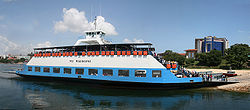
Ferry boats often dock at specialized facilities designed to position the boat for loading and unloading, called a ferry slip. If the ferry transports road vehicles or railway carriages there will usually be an adjustable ramp called an apron that is part of the slip. In other cases, the apron ramp will be a part of the ferry itself, acting as a wave guard when elevated and lowered to meet a fixed ramp at the terminus — a road segment that extends partially underwater.
The ferry shown right is ferry MV Magogoni used in Tanzania. It was not possible to build suitable docking facilities and that problem is solved by making the ferry extra manoeuvrable. Four identical engine modules with Schottel pump-jets are used for main propulsion. With her steering propellers rotating round vertical shafts she can be put on any place of the ramp, regardless of stream.
First, shortest, largest

On 11 October 1811 inventor John Stevens' ship the Juliana, began operation as the first steam-powered ferry (service was between New York City, and Hoboken, New Jersey). [citation needed]
The Elwell Ferry, a cable ferry in North Carolina travels a distance of 110 yards[4], shore to shore, with a travel time of five minutes.[5]
The oldest ferry service in continuous operation is the Rocky Hill - Glastonbury Ferry, running between the towns of Rocky Hill and Glastonbury, Connecticut. [citation needed] Established in 1655, the ferry has run continuously since, only ceasing operation every winter when the river freezes over. The oldest continuously running salt water ferry service may be the Halifax/Dartmouth ferry, running between the cities of Halifax and Dartmouth, Nova Scotia, which has run year-round since 1752, and is currently run by the region's transit authority, Metro Transit.[6]

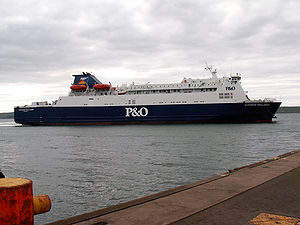
Another contender for oldest ferry is the Mersey Ferries service from Liverpool to Birkenhead, England. There is evidence that there has been a ferry service over the river for over 800 years. Liverpool's city charter in 1207 specifies rights of passage across the river payable by a toll. [citation needed]
Two of the world's largest ferry systems are located in the Strait of Georgia, in the Canadian province of British Columbia, and Puget Sound, in the U.S. state of Washington. BC Ferries in British Columbia operates 36 vessels, visiting 47 ports of call, while Washington State Ferries owns 28 vessels, travelling to 20 ports of call around Puget Sound. Sydney Ferries in Sydney, Australia operates 31 passenger ferries in Port Jackson (Sydney Harbour), carrying 18 million passengers annually. It operates catamarans and other types of ferries on these routes, with the most famous likely being the Circular Quay-Manly route. Between 1938 and 1974 this route operated the South Steyne, billed at the time as the largest and fastest ferry of its type. Sydney Ferries became an independent corporation owned by the government in 2004.
Some of world's busiest ferry routes include the Star Ferry in Hong Kong and the Staten Island Ferry in New York City.
Metrolink Queensland operates 21 passenger ferries on behalf of Brisbane City Council, 12 being single-hulled ferries and 9 CityCats (catamarans), along the Brisbane River from the University of Queensland through the city to Brett's Wharf.
World's Fastest Diesel Ferry
Austal’s 65-metre (213 ft) Auto Express catamaran ferry “Shinas”, built for the Sultanate of Oman, has achieved a record service speed of 52 knots (96 km/h; 60 mph) during sea trials, making it the fastest diesel-powered vehicle-passenger ferry currently in commercial service.[7] The vessel’s confirmed service speed of 52 knots (96 km/h; 60 mph) exceeds contract requirements by one knot, with the vessel also reaching a peak speed of 55.9 knots (103.5 km/h; 64.3 mph). “Shinas” is the first of two identical vessels being built for the Sultanate of Oman at Austal’s facilities in Henderson, Australia.
Each vessel will carry 208 passengers and 56 cars along a 180-nautical-mile (330 km; 210 mi) route between Shinas and Oman’s rugged Musandam Peninsular. The vessel has the capability to assist in search and rescue operations due to its helicopter landing facility, which is suitable for a medium class helicopter. Both vessels are powered by four MTU 20 cylinder 1163 series diesel engines each producing 6,500 kW (8,717 hp) and driving Rolls-Royce / Kamewa waterjets. The vessels meet Det Norske Veritas survey requirements and conform to the HSC code.
The full length vehicle deck allows space for 56 cars or 54 truck lane metres plus 40 cars with a deck clear height of over three metres. The vehicle deck aft can withstand axle loads of 9 t (Template:Convert/ST LT) (single wheel) or 12 t (Template:Convert/ST LT) (dual wheel). The remainder of the main deck caters for maximum axle loads of 3 t (Template:Convert/ST LT) (single wheel). Lightweight structural fire protection, zoned sprinkler systems and hydrants ensure optimal fire safety during vehicle transport. As an added safety measure, the vessel has a medical transfer station accessible off the vehicle deck, offering a high level of medical equipment for patient transport. The vessel’s high operating speed is made possible by four MTU 20 cylinder 1163 series diesel engines, each producing 6,500 kW (8,717 hp) and driving Rolls-Royce / Kamewa waterjets.
Since August 2008 the world's fastest passenger ferry launched service between Muscat and Musandam.[8]
Sustainability
The contributions of ferry travel to climate change have received less scrutiny than land and air transport, and vary considerably according to factors like speed and the number of passengers carried. Average carbon dioxide emissions by ferries per passenger-kilometre seem to be 0.12 kg (4.2 oz).[9] However, 18-knot ferries between Finland and Sweden produce 0.221 kg (7.8 oz) of CO2, with total emissions equalling a CO2 equivalent of 0.223 kg (7.9 oz), while 24–27-knot ferries between Finland and Estonia produce 0.396 kg (14.0 oz) of CO2 with total emissions equalling a CO2 equivalent of 0.4 kg (14 oz).[10]
With the price of oil at high levels, and with increasing pressure from consumers for measures to tackle global warming, a number of innovations for energy and the environment were put forward at the Interferry conference in Stockholm. According to the company Solar Sailor, hybrid marine power and solar wing technology are suitable for use with ferries, private yachts and even tankers.[11]
See also
| ||||||||||||||||||||||||||
| |||||||||||||||||||
References
| 50x40px | This article includes a list of references or external links, but its sources remain unclear because it has insufficient inline citations. Please help to improve this article by introducing more precise citations where appropriate. (January 2009) |
- ↑ Unknown author. "Pride of Burgundy". http://www.passengerships.fsnet.co.uk/pride%20of%20burgundy.htm. Retrieved 2007-12-01.
- ↑ ATAN official web page: Fast Ferries – pointless gas-guzzlers
- ↑ Faeri Verein Basel
- ↑ "Elwell Ferry, Kelly, NC". Living in Style, August/September 2008, Christopher E. Nelson. http://adserver1.harvestadsdepot.com/tnwsobsvr/ss/085850/074/074.shtml?074_001/074_001.shtml.
- ↑ "Elwell Ferry: When getting ‘away’ is closer than you think". Star News Online, Jim Hanchett, December 2, 2005. http://www.starnewsonline.com/article/20051205/COLUMNIST33/51202028?Title=Elwell-Ferry-When-getting-145-away-146-is-closer-than-you-think.
- ↑ Halifax Regional Municipality (Metro Transit) page – "Harbour Ferries"
- ↑ http://www.gulfnews.com/News/Gulf/oman/10232063.html Oman launches high-speed ferry
- ↑ "World's fastest passenger ferry". http://www.theweek.co.om/discon.aspx?Cval=934.
- ↑ Philippe Holthof, 'SOx and CO2 Emissions once again Hot Topic at Ferry Shipping Conference', Ferry Shipping Conference 08: Building Bridges in the Industry, accessed from http://www.shippax.se/backnet/ext/file/fileredirect.asp?id=229&file=bilaga_konferens_maj08.pdf April 10th 2009, p. 3.
- ↑ http://lipasto.vtt.fi/yksikkopaastot/henkiloliikennee/vesiliikennee/autolauttae.htm accessed 3rd July 2009
- ↑ Interferry hears about green alternatives
External links
- Example of double-ended ferry of the Jamestown Ferry system.
- Example of "turntable ferry" in operation
- DBB ferries for sale on offer
| |||||||||||||||||||
bg:Ферибот ca:Transbordador cs:Přívoz da:Færge de:Fähre nv:Tsin naaʼeeł diné bee nágéhéʼ et:Parvlaev el:Πορθμείο es:Transbordador eo:Pramo fr:Ferry (bateau) fy:Fear gd:Aiseag hr:Trajekt id:Kapal feri is:Ferja it:Traghetto he:מעבורת lb:Fär lt:Keltas hu:Komp mk:Ферибот ms:Feri nl:Veerboot ja:フェリー no:Ferje nn:Ferje pl:Prom pt:Balsa ru:Паром scn:Trachettu simple:Ferry sl:Trajekt szl:Fera sr:Трајект sh:Trajekt su:Féri fi:Autolautta sv:Färja tr:Feribot uk:Пором vi:Phà zh:渡輪
- Articles to be expanded from June 2008
- Articles with invalid date parameter in template
- All articles to be expanded
- All articles with unsourced statements
- Articles with unsourced statements from August 2009
- Pages with broken file links
- Articles lacking in-text citations from January 2009
- All articles lacking in-text citations
- Boat types
- Ship types
- Ferries




